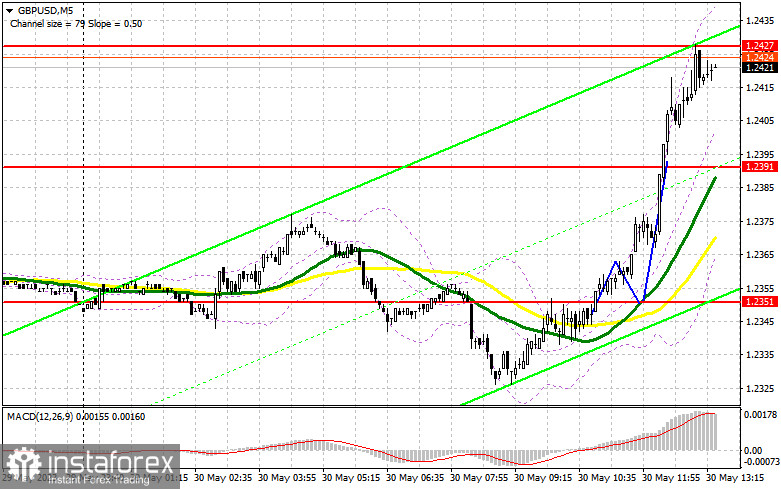In my morning forecast, I drew attention to the level of 1.2351 and recommended making trading decisions based on it. Let's look at the 5-minute chart and analyze what happened there. The breakout of this area occurred without a top-down retest, which did not provide a buying signal for the pound. The technical picture was completely reassessed in the second half of the day.

To open long positions on GBP/USD, the following is required:
Considering the return of demand for the British pound and the long-awaited upward correction for the pair, it can be assumed that the bulls will show themselves in the second half of the day after the reports on the US economy. The Consumer Confidence Index and Housing Price Index numbers are expected. Positive data will likely pressure the pound, allowing buyers to enter the market at more attractive prices.
For this reason, I expect a downward correction of the pair towards 1.2391 during the day and act from there. A false breakout at that level will provide an excellent entry point for buying, leading to a surge in the pair toward the new resistance level at 1.2442. A breakout and retest of that range from top to bottom will provide an additional signal to open long positions and strengthen the presence of bulls in the market, with a surge towards 1.2483 at the beginning of the week. The ultimate target will be the area at 1.2532, where I will take profit. If the pound declines to around 1.2391 and there is no activity from buyers, I will postpone market entry until the minimum at 1.2350, where the moving averages are located, playing on the side of the bulls. I will also open long positions there only on a false breakout. I plan to buy GBP/USD immediately on a rebound only from the monthly minimum at 1.2308, with a 30-35 point correction target during the day.
To open short positions on GBP/USD, the following is required:
Sellers tried their best, but the data on sharp price increases in British supermarkets reminded traders that the Bank of England was in a hurry, claiming that interest rates would peak soon. According to the British Retail Consortium, the annual inflation rate in British stores jumped to 9.0% year-on-year.

Now the most important thing for sellers is to take advantage of the new resistance level at 1.2442, where the pair is heading. Only a false breakout there will restore confidence to sellers, providing a selling signal with a downward movement towards the support at 1.2391, which was formed in the first half of the day. A breakout and retest from the bottom to the top of that range will bring balance to the market and form a signal to open short positions with a decline toward 1.2350. The ultimate target remains the monthly minimum at 1.2308, where I will take profit. If GBP/USD rises and there is no activity at 1.2442 in the second half of the day, sellers' stop orders will come into play again, leading to further upward correction of the pair. In that case, I will postpone the sales until the resistance test at 1.2483. A false breakout there will serve as an entry point for short positions. I will sell GBP/USD immediately on a rebound only from 1.2532 but with the expectation of a downward correction of the pair by 30-35 points during the day.
The COT (Commitment of Traders) report for May 23rd showed a reduction in both long and short positions. Last week, the decline of the British pound continued, but judging by the reduction in positions of both types, the change in the balance of power is minimal. Fear of a lack of agreement on the US debt limit and the onset of a recession forced traders to close positions, especially in the face of further uncertainty regarding the monetary policy of the Bank of England. According to the regulator's statements, there may be a pause in the cycle of interest rate hikes, but inflationary pressure in the UK does not allow it. The latest COT report stated that non-commercial short positions decreased by 7,181 to 57,614, while non-commercial long positions fell by 8,185 to the level of 69,203. This led to a decrease in the non-commercial net position to 11,059 against 12,593 the previous week. The weekly price decreased and reached 1.2425 compared to 1.2495.

Indicator signals:
Moving Averages
Trading is conducted above the 30-day and 50-day moving averages, indicating an upward correction of the pair.
Note: The author considers the period and prices of the moving averages on the hourly chart (H1), which differs from the general definition of classical daily moving averages on the daily chart (D1).
Bollinger Bands
In case of a decline, the lower boundary of the indicator, around 1.2325, will act as support.
Description of Indicators:
- Moving Average (defines the current trend by smoothing volatility and noise). Period 50. Marked in yellow on the chart.
- Moving Average (defines the current trend by smoothing volatility and noise). Period 30. Marked in green on the chart.
- MACD Indicator (Moving Average Convergence/Divergence). Fast EMA period 12. Slow EMA period 26. SMA period 9.
- Bollinger Bands. Period 20.
- Non-commercial traders: speculators such as individual traders, hedge funds, and large institutions using the futures market for speculative purposes and meeting certain requirements.
- Long non-commercial positions represent the total long open position of non-commercial traders.
- Short non-commercial positions represent the total short open position of non-commercial traders.
- The non-commercial net position is the difference between non-commercial traders' short and long positions.
 English
English 
 Русский
Русский Bahasa Indonesia
Bahasa Indonesia Bahasa Malay
Bahasa Malay ไทย
ไทย Español
Español Deutsch
Deutsch Български
Български Français
Français Tiếng Việt
Tiếng Việt 中文
中文 বাংলা
বাংলা हिन्दी
हिन्दी Čeština
Čeština Українська
Українська Română
Română

